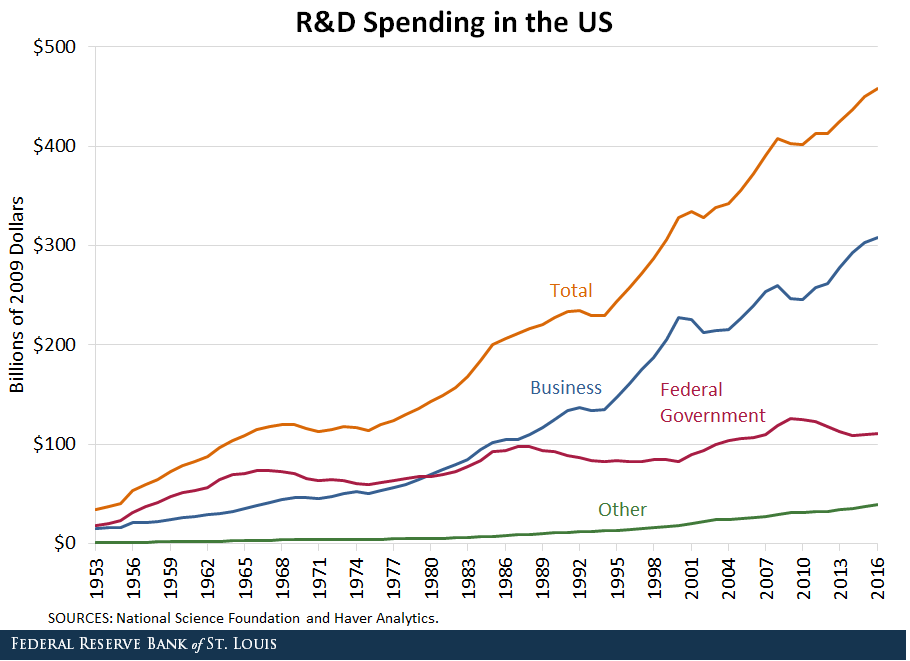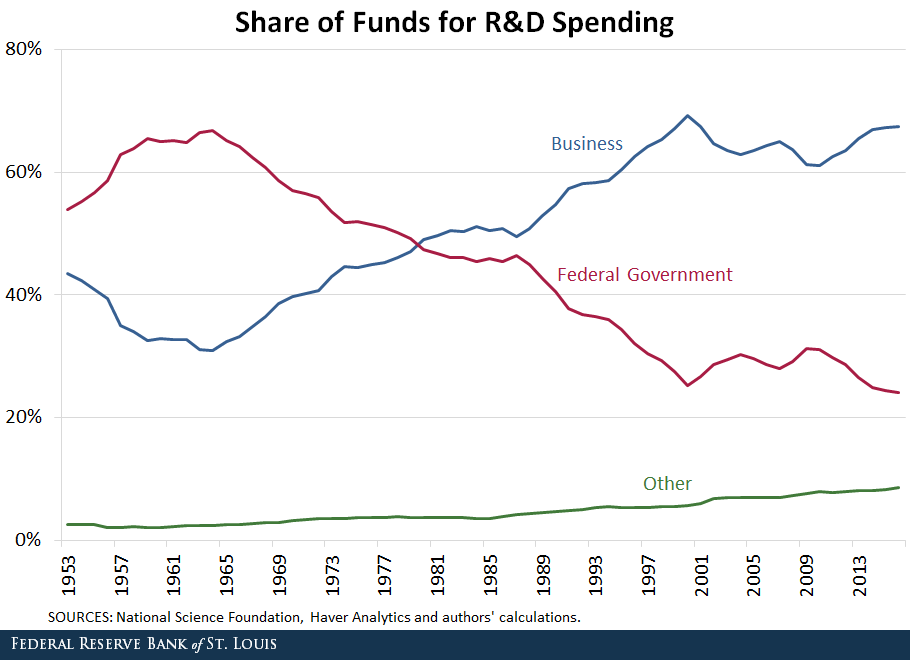Research And Development: Business Spending Up, Government Spending Flat
from the St Louis Fed
-- this post authored by Ana Maria Santacreu, Economist, and Heting Zhu, Senior Research Associate
Total research and development (R&D) spending in the U.S. has increased dramatically since the mid-1950s. It grew from $34 billion in 1953 to more than $457 billion in 2016, an increase of 1244.3 percent, as seen in the figure below. (Note that these amounts are in 2009 dollars.)


During this period, the main sources of funding of R&D spending have been the business sector and the federal government. Although some other sectors, such as universities and colleges, have increased their R&D spending over the years, the business sector and the federal government combined accounted for 91.4 percent of the total R&D funding in 2016 in the U.S., down from 97.5 percent in 1953.
Changes in R&D Spending Share
The individual contribution of the two main sources of funding has shifted over time. During the '50s, '60s, and '70s, the federal government was the main contributor of funding. In more recent years, the business sector has become the main source.1
In the previous figure, we saw that the amount of R&D funded by the business sector has increased at roughly the same pace as total R&D spending. However, funding from the federal government has remained almost constant, declining after 2009.
In particular, businesses funded 43.5 percent of total R&D spending in 1953, whereas the federal government funded 53.9 percent. In 2016, businesses funded 67.4 percent of total R&D spending whereas the federal government funded 24.1 percent.
The contrast between business and federal government contributions to funding is even more striking when we look at the share of R&D spending, seen in the figure below.

The contribution of business funding to total R&D has increased significantly over time, while the contribution of funding from the federal government has been declining.
Explanations and Challenges
A major contributor to the decline in government R&D spending was the Budget Control Act of 2011, which limited discretionary federal spending. Recent policies may also exacerbate these trends in funding contribution from the federal government.
In previous articles, we have stressed the importance of R&D spending for productivity and growth.2 Current trends suggest that total R&D spending will continue to increase as long as the business sector keeps up funding innovation. Therefore, policies promoting R&D in the corporate sector are likely to spur innovation and growth in the U.S.
Notes and References
1 Mervis, Jeffrey. “Data check: U.S. government share of basic research funding falls below 50%." Science, March 9, 2017.
2 See Santacreu, Ana Maria, and Zhu, Heting. “Manufacturing and Service Sector Roles in the Evolution of Innovation and Productivity." Federal Reserve Bank of St. Louis Economic Synopses, 2018 No.2; Santacreu, Ana Maria, and Zhu, Heting. “Has China Overtaken the U.S. in Terms of Innovation?" Federal Reserve Bank of St. Louis, On the Economy Blog, March 12, 2018; and Santacreu, Ana Maria and Zhu, Heting. “How Did South Korea’s Economy Develop So Quickly?" Federal Reserve Bank of St. Louis, On the Economy Blog, March 20, 2018.
Additional Resources
- Economic Synopses: Manufacturing and Service Sector Roles in the Evolution of Innovation and Productivity
- On the Economy: Has China Overtaken the U.S. in Terms of Innovation?
- On the Economy: How Did South Korea’s Economy Develop So Quickly?
Disclaimer: Views expressed are not necessarily those of the Federal Reserve Bank of St. Louis or of the Federal Reserve System.
Disclosure: None.



